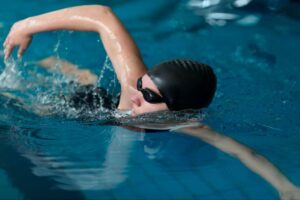By the numbers: why adding hands on, movement first care matters
- After knee replacement, programs that include targeted manual therapy often see 10 to 20 degrees more knee bend by 8 to 12 weeks.
- Patients who combine hands on care with guided exercise report faster drops in pain and stiffness in the first three months.
- Early, efficient movement retraining can reduce time to key milestones like independent walking, stairs, and comfortable sit to stand.
- Many people return to work or daily routines one to two weeks earlier when swelling control, joint glide, and movement quality are addressed from the start.

Case snapshot: back to life sooner
Rhea, 52, had a total knee replacement. In her first sessions we focused on settling swelling, restoring kneecap and knee joint glide, and retraining Core First strategies for sit to stand and stairs. Once her movement felt easy and smooth, we layered strength and walking cadence. She met her walking goal without a next day flare and returned to desk work earlier than planned.
Why recoveries stall even when the surgery went well
- Guarded movement and swelling limit joint glide, so nearby areas overwork.
- Scar and fascial stiffness create sticky mechanics that resist smooth motion.
- Pain changes timing so key stabilisers switch off and big movers try to do everything.
- Load jumps too soon and activity spikes trigger next day pain, so progress yo yos.
How FMT™ shortens downtime and raises the ceiling
Functional Manual Therapy blends precise hands on treatment with movement retraining and progressive loading in one session.
1) Free the restriction
Targeted joint and soft tissue techniques restore the specific glides your new joint or repaired tissue needs to move comfortably.
2) Switch on efficient control
You learn Core First strategies and scapular or lumbopelvic control so force flows through the system without overloading the surgical site.
3) Relink the chain
Hips, trunk, and foot mechanics sync with the operated area, cutting compensations that keep pain lingering.
4) Reload with precision
Strength, gait, and return to task progress in clear steps, advancing only when the 24 hour symptom check is clean.
Common post-surgical paths we support
| Surgery | Early barriers you feel | What we do first | Ready to progress cues |
|---|---|---|---|
| Total knee replacement | Swelling, limited bend, stiff kneecap, quad shutdown | Patellar and tibiofemoral mobilisation, swelling control, quad activation in safe ranges | Knee bend rising session to session, straight leg raise without lag, comfortable step downs |
| ACL reconstruction | Tendon tenderness, guarded gait, poor balance | Restore knee and fibular glide, neuromuscular control, closed chain strength | Symmetrical weight bearing, pain free mini squat, controlled single leg balance |
| Rotator cuff repair | Night ache, painful elevation, unsteady shoulder blade | Gentle capsular and scapular work, cuff setting in supported positions | Pain free active elevation to a set target, steady shoulder blade control |
| Hip replacement | Hip flexor tightness, hip drop when walking, stride asymmetry | Anterior hip glide, pelvic control, cadence and step length tuning | Stable single leg stance, equal stride length, stairs without hitch |
| Fracture fixation wrist or ankle | Stiff joint, protective grip or gait, soft tissue sensitivity | Pain free mobilisation with movement, desensitisation, graded grip or foot loading | Range landmarks met, smooth roll through in gait or pain free functional grip |

Your first 14 days with us
- Settle and move: Calm swelling, restore key joint glides, begin comfortable ranges from day one.
- Re educate: Core First patterns for sit to stand, gait, stairs, reach, or grip.
- Strength that sticks: Short, supervised sets that do not spike next day symptoms.
- Measure and progress: Clear range and function checkpoints. If the 24 hour check is clean, we advance.
When to speak to your surgeon now
Fever, calf pain or swelling, wound redness or discharge, sudden sharp pain with loss of function, new numbness, chest discomfort or shortness of breath. Pause therapy and contact your surgical team immediately.
Why choose VARDĀN for post-surgical rehab
- Dedicated FMT™ care delivered one on one by globally trained therapists.
- Post Surgical and Rehabilitation programs that blend manual therapy, movement retraining, and progressive conditioning.
- Clinical Pilates and advanced physiotherapy on site to build durable strength and control.
- A movement first approach that focuses on the root cause and efficient, confident return to life.

Move smarter. Heal faster. Live better.
You do not need to wait it out. You need the right plan, paced to your body and your surgery.
Request an Appointment at VARDĀN, Lajpat Nagar, New Delhi for a personalised Functional Manual Therapy assessment and a sport specific rehab plan.
Call us today at +91 011 43580720-22 / 9810306730
📅 Book your root-cause consultation at www.vardan.in
📍 Visit our advanced physiotherapy clinic in Delhi in Lajpat Nagar
Ready to move pain-free? Book your personalized consultation with VARDĀN today!
Frequently Asked Questions
As soon as your surgeon clears you, often within days for joint replacements and fracture fixations. Early gentle work around the surgical area helps range and comfort without stressing the repair.
Yes when performed by trained clinicians who respect healing timelines. We work around the incision at first, focus on swelling control and safe glides, and only progress deeper techniques when tissues are ready.
FMT™ integrates hands on restoration, neuromuscular re education, and movement retraining in a single session with Core First strategies and one on one guidance, then layers sport or task specific progressions.
Most people see steady gains in range, function, and comfort when manual therapy is combined with a structured program. The goal is predictable progress without next day flare and a safe, confident return to daily life or work.




